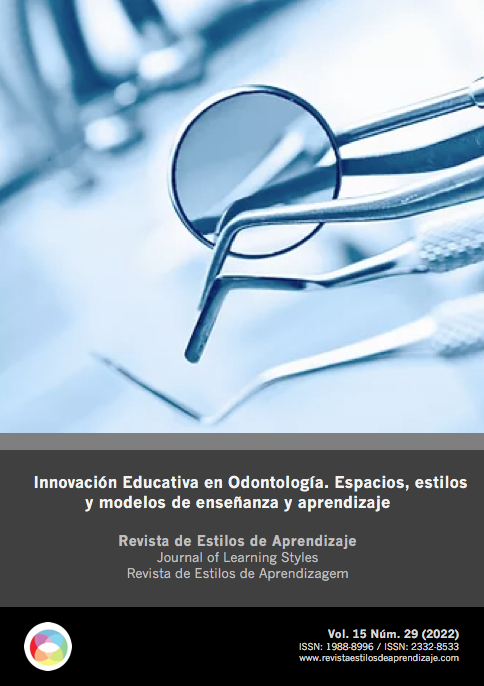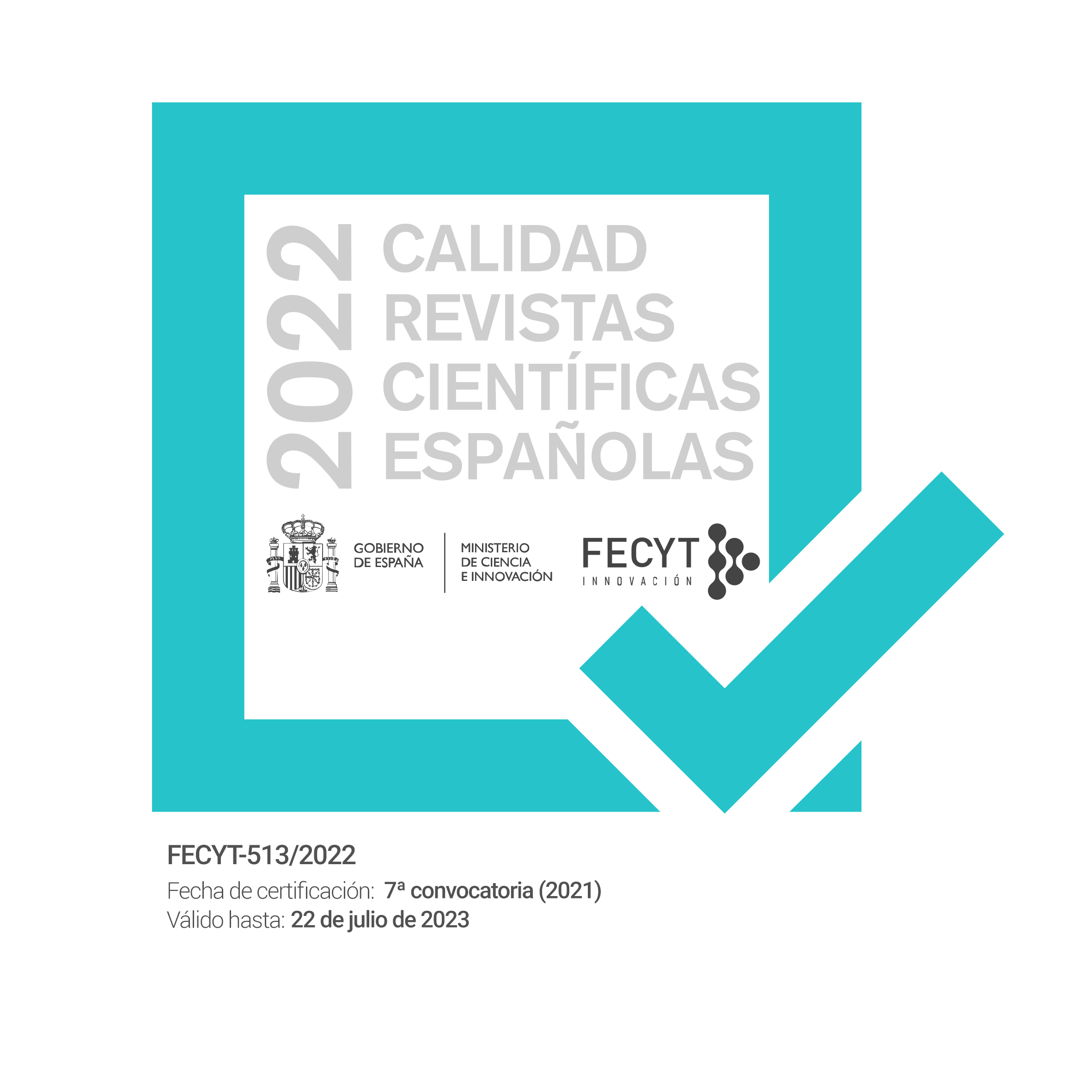Transformar o espaço educativo universitário através do Fluxo Musical em estudantes de medicina dentária de graduação durante a pandemia da COVID-19: um estudo piloto
DOI:
https://doi.org/10.55777/rea.v15i29.4130Palavras-chave:
Ansiedade, Universidade, Estudantes, Música, Fluxo musicalResumo
Os estudantes de medicina dentária estão sujeitos a altos níveis de stress e ansiedade. A música tem sido utilizada em vários campos para melhorar a atenção e o desempenho dos estudantes. O objectivo deste estudo-piloto era testar como a incorporação do projecto Music Flow na actividade clínica pode controlar os níveis de ansiedade, melhorando a experiência educacional durante os estágios dentários dos estudantes de medicina dentária. 119 estudantes de diferentes nacionalidades, estudantes do 5º ano, foram incluídos e divididos em dois grupos: o grupo I (n=63) ouvia música; o grupo II (n=56) não ouvia qualquer tipo de música e actuava como um controlo. Utilizando uma Escala Analógica Visual (EVA) e um questionário preenchido pelos estudantes, registámos o seu grau de ansiedade pré e pós-operatória, e a influência da música durante a sua prática clínica. Oitenta e seis por cento considerou a música como um instrumento útil para diminuir a sua ansiedade; para 89% foi capaz de melhorar a sua prática clínica. O grupo I sofreu uma diminuição da ansiedade de acordo com o VAS de 1,76 pontos; o grupo II de 0,85 pontos. COVID-19 aumentou a ansiedade dos estudantes em 58%. A incorporação do Fluxo Musical durante a prática clínica pode diminuir o seu nível de ansiedade, melhorando o desenvolvimento da sua actividade clínica.
Downloads
Referências
Alzahem, A., van der Molen, H., Alaujan, A., Schmidt, H. & Za-makhshary, M. (2011). Stress amongst dental students: a systematic review. Eur J Dent Educ, 15(1), 8-18.
Al-Sowygh, Z., Alfadley, A., Al-Saif, M. & Al-Wadei, S. (2013). Perceived causes of stress among Saudi dental students. King Saud University Journal of Dental Sciences, 4(1), 7-15.
Appukuttan, D., Vinayagavel, M., & Tadepalli, A. (2014). Utility and validity of a single-item visual analog scale for measuring dental anxiety in clinical practice. J Oral Sci, 56, 151-6.
Báez, A. (2018). Inteligencia emocional y estilos de aprendizaje aplicados en el grado universitario de turismo en Tenerife. Revista De Estilos De Aprendizaje, 11(22).
Basudan, S., Binanzan, N. & Alhassan, A. (2017). Depression, anxiety, and stress in dental students. International Journal of Medical Education, 8, 179-186.
Bharadwaj, R. (2017). Effect of Music Therapy os Stress and Anxiety of University Students. International Journal for Innovate Research in Multidisciplinary Field, 3(5).
Bradt, J., Dileo, C. & Potvin, N. (2013). Music for stress and anxiety reduction in coronary heart disease patients. Cochrane Database of Systematic Reviews. Issue 12. Art. No.: CD006577. DOI: 10.1002/14651858.CD006577.pub3.
Di Nasso, L., Nizzardo, A., Pace, R., Pierleoni, F., Pagavino, G. & Giuliani, V. (2016). Influences of 432 Hz Music on the Perception of Anxiety during Endodontic Treatment: A Randomized Controlled Clinical Trial. Journal of Endodontics, 42(9), 1338-1343. https://doi.org/10.1016/j.joen.2016.05.015.
García, Y., Morales, S. & Rodríguez, V. (2020). Abordaje de experiencias educativas digitales ante la crisis del COVID-19 en el contexto universitario con el alumnado de diversidad funciona. Revista De Estilos De Aprendizaje, 13(20).
Generali, L., Iani, C., Macaluso, G., Montebugnoli, L., Siciliani, G. & Consolo, U. (2020). The perceived impact of the COVID-19 pandemic on dental undergraduate students in the Italian región of Emilia-Romagna. Eur J Dent Educ, 25(3), 621-633. https://doi.org/10.1111/eje.12640.
Ghasemi, M., Lotfollahzadeh, H., Kermani-Ranjbar, T. & Javad, M. (2017). Effect of Music Practice on Anxiety and Depression of Iranian Dental Students. J Dent (Tehran), 14(3):138-143.
Gupta, A. & Ahmed, B. (2020). Experience of listening to music on patient anxiety during minor oral surgery procedures: a pilot study. British dental Journal, 228(2), 89-91. https://doi.org/10.1038/s41415-019-1162-1.
Keilani, C., Simondet, N., Maalouf, R., Yigitoglu, A., Bougrine, A., Simon, D., ... Fligny, I. (2017). Effects of music intervention on anxiety and pain reduction in ambulatory maxillofacial and otorhinolaryngology surgery: a descriptive survey of 27 cases. Oral and maxillofacial surgery, 21 (2), 227-232. https://doi.org/10.1007/s10006-017-0616-3.
Khan, S., Ibrahim, S., Butt, R., Ahmed, B. & White, D. (2020). The influence of gender on career aspira tions of University of Birmingham dental students and junior trainees in the West Midlands. British Dental Journal, 228(12), 933-937. http://dx.doi.org/10.1038/s41415-020-1704-6
Khanagar, S., Al-Ehaideb, A., Jamleh, A., Ababneh, K., Maganur, P. & Vishwanathaiah. (2021). Psychological Distress among Undergraduate Dental Students in Saudi Arabia and Its Coping Strategies: A Systematic Review. Healthcare, 9, 429. https://doi.org/10.3390/healthcare9040429.
Kim, YK., Kim, SM., & Myoung, H. (2011). Musical intervention reduces patients' anxiety in surgical extraction of an impacted mandibular third molar. Journal of oral and maxillofacial surgery, 69 (4), 1036-1045. https://doi.org/10.1016/j.joms.2010.02.045.
Kumar, N., Wajidi, M., Chian, Y., Vishrooti, S., Ravindra, S. & Aithal, A. (2016). The effect of listening to music on concentration and academic performance of the student: Cross-sectional study on medical undergraduate students. Research Journal of Pharmaceutical, Biological and Chemical Sciences, 7(6),1190-1195.
Kupeli, I., & Gülnahar, I. (2020). Comparing Different Music Genres in Decreasing Dental Anxiety in Adolescents Who Underwent Third Molar Tooth Surgery in Turkey - Randomized Controlled Trial. Journal of oral and maxillofacial surgery, 78(4), 546.e1-546.e7. https://doi.org/10.1016/j.joms.2019.11.029.
Malakoutikhah, A., Dehghan, M., Ghonchehpoorc, A., Parandeh, P., & Honarmand, A. (2020). The effect of different genres of music and silence on relaxation and anxiety: A randomized controlled trial. Explore (New York, N.Y.). https://doi.org/10.1016/j.explore.2020.02.005.
Nilsson, U. (2008). The Anxiety- and Pain-Reducing Effects of Music Interventions: A systematic Review. AORN Journal, 87(4), 780-807. https://doi.org/10.1016/j.aorn.2007.09.013.
Prinz, P., Hertrich, K., Hirschfelder, U. & de Zwaan M. (2012). Burnout, depression and depersonalisation--psychological factors and coping strategies in dental and medical students. GMS Z Med Ausbild, 29(1): Doc10.
Schlaug, G. (2015). Musicians and music making as a model for the study of brain plasticity. Progress in brain research. 37-55. http://dx.doi.org/10.1016/bs.pbr.2014.11.020.
Yildirim, T. & Atas, O. (2021). The evaluation of psychological state of dental students during the COVID-19 pandemic. Braz. Oral Res. 35: e069 .

Downloads
Publicado
Como Citar
Edição
Secção
Licença
Ao submeter o original, o(s) autor(es) declara(m) ter conhecimento e aceitar, na íntegra, a política de privacidade, bem como os direitos de autor da Revista Estilos de Aprendizagem.
A Revista Estilos de Aprendizaje oferece acesso livre e gratuito ao seu conteúdo, a fim de levar a investigação científica aos seus leitores e à sociedade em geral. Todo o conteúdo digital é de acesso livre e gratuito e é publicado sob uma licença Creative Commons:

A cessão de direitos é feita sob a licença Creative Commons Reconocimiento-NoComercial-SinObraDerivada 4.0 Internacional (CC-BY-NC-ND 4.0)
The Learning Styles Magazine é uma revista de acesso aberto. A publicação de artigos ou resenhas na Revista não lhe dá direito a qualquer remuneração. Da mesma forma, tanto para os autores como para os leitores, a revista é gratuita Creative Commons Reconocimiento-NoComercial-SinObraDerivada 4.0 Internacional (CC-BY-NC-ND 4.0).
Com Esta licença permite a reprodução e divulgação do conteúdo da revista para transmissão educativa, social e de conhecimento, sem fins lucrativos e desde que não sejam modificados, citando a origem e a autoria. A licença concedida à Revista Estilos de Aprendizaje permite a cópia e distribuição do conteúdo da revista, desde que a autoria da obra seja reconhecida, especificando correctamente o autor e a entidade editora. A obra não pode ser utilizada para fins comerciais, nem pode ser alterada, transformada ou gerada a partir desta obra. A publicação de artigos ou resenhas na Revista não dá direito a qualquer remuneração.
A Revista Estilos de Aprendizagem convida o autor/autores a aumentar a visibilidade e o âmbito dos seus artigos publicados através da sua redifusão em:
- Espaços Web e redes pessoais, bem como em reuniões e fóruns científicos
- Arquivos institucionais abertos em Universidades, repositórios educacionais e Centros de Investigação
- Redes académicas e científicas (Researchgate, Academia.edu, Plubons, etc.)
Todos estes espaços e publicações devem incluir todos os dados bibliográficos da publicação.
























